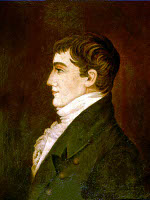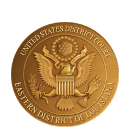 Thomas Bolling Robertson played a significant role in the origins of Louisiana as an American territory and State, capped by his service as the third United States District Judge for both the Eastern and Western Districts of Louisiana.
Thomas Bolling Robertson played a significant role in the origins of Louisiana as an American territory and State, capped by his service as the third United States District Judge for both the Eastern and Western Districts of Louisiana.
Judge Robertson was born into an influential and distinguished Petersburg, Virginia, family on February 27, 1779. According to Ned Hemard in his 2010 article "New Orleans in 1810" for the New Orleans Bar Association, Judge Robertson was "a descendent of Pocahontas and John Rolfe." He was the son of William Robertson and Elizabeth Bolling Robertson. His younger brother John later became Virginia Attorney General, Lieutenant Governor, Congressman, and Circuit Judge, while another brother, Wyndham, became a Virginia legislator, Lieutenant Governor, and Governor.
Judge Robertson was educated at The College of William and Mary and "read law" in Virginia in 1806. He moved to Louisiana and served as Attorney General of the Territory of Orleans from 1806 to 1807, when President Thomas Jefferson appointed him Secretary of the Territory of Orleans, a position in which he served until 1812. During that time, his official portrait was painted by the famous artist St. Memin.
A Jeffersonian Democratic-Republican, he was elected the first United States Representative to Congress from Louisiana in 1812 and served until 1818. While in Congress, he traveled to France and was present in Paris when Napoleon returned from his defeat at Waterloo and abdicated his Empire. During that time, he wrote extensively about his observations in France, and many of his letters were published in the book Journal of Events in Paris (1815). He resigned from Congress in 1818 because "[m]y health has been so seriously affected by the cold winters of Washington."
Returning to New Orleans, he was Louisiana Attorney General from 1819 to 1820. In 1820, he was elected the third Governor of Louisiana. Governor Robertson successfully implemented a series of internal improvements, including opening the Pearl and Red Rivers to navigation, constructing Louisiana's portion of "the national road," creating the Bank of Louisiana and funding Charity Hospital with money from licensing New Orleans gambling houses. Despite these achievements, Robertson's term was blighted by serious and occasionally violent clashes between Creoles and Americans, who were engaged in ethnic rivalry over control of the new State.
In 1824, he resigned as Governor to accept an appointment as United States District Judge for the combined Eastern and Western Districts of Louisiana. He was nominated for the federal bench by President James Monroe on May 24, 1824, was confirmed by the Senate, and received his commission two days later. The available records contain little information on cases he may have decided on the federal bench, indicative perhaps of a routine and low key docket. Judge Robertson died at the age of 49 on October 5, 1828, in White Sulphur Springs, Virginia (now West Virginia), where he is buried. The current Robertson Street in New Orleans is named in his honor.
